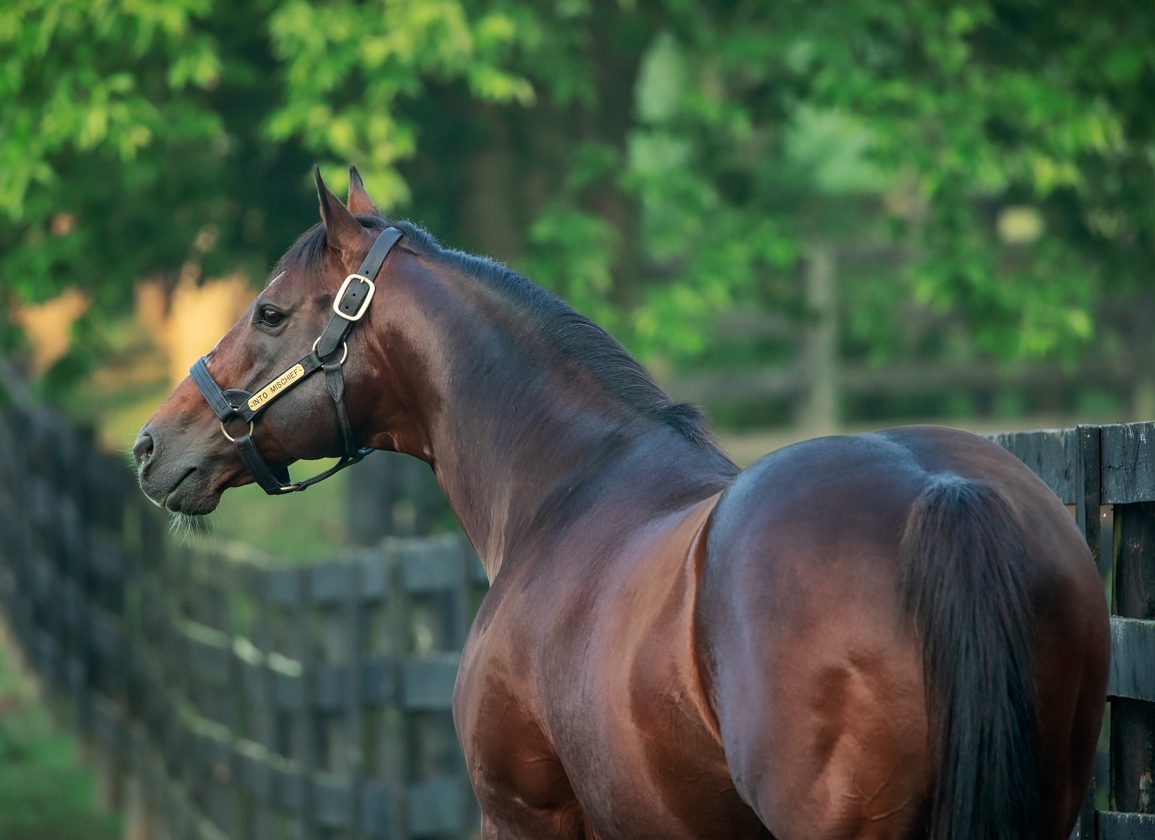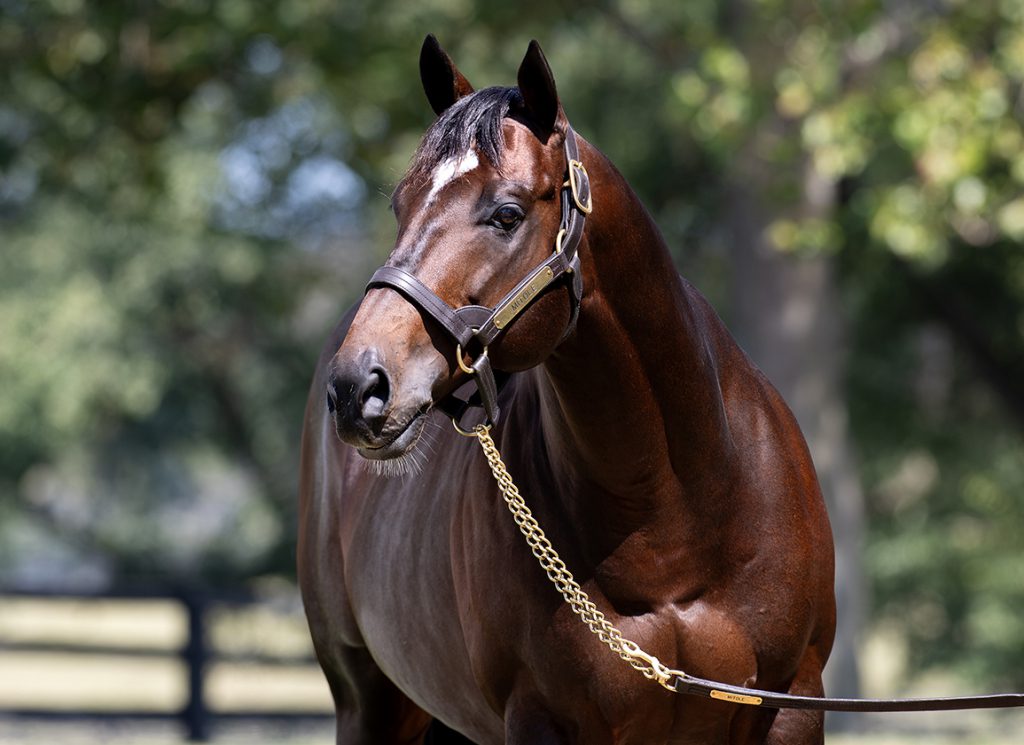By Chris McGrath
By this stage, we can really talk about living in “the Into Mischief era.” Not just because the Spendthrift phenomenon ends 2023 by sealing a fifth consecutive general sires' title, but also because he has become the definitive stallion of our times.
In some respects, New Year's Day is a more literal turning point for our sport than other walks of life. For bureaucratic purposes, the weanlings of today become the short yearlings of tomorrow; and Into Mischief himself takes one step closer to veteran status, as he enters his 19th year. On the other hand, our cycles demand too much patience for anyone simply to wipe the slate clean every year. Every program, on or off the track, enters 2024 with a pretty clear trajectory. That may depend on how many (or few) mares your stallion has covered over the past two or three years; or perhaps on the caliber of those randomly selected by fate for the injuries annually inevitable in the paddocks or in training.
And, actually, it is precisely those two variables that have combined to create the age of Into Mischief, and the industrial system on which he has built his hegemony. Quality still sells, as he has shown, but nowadays it's commercially imperative to have a foundation of quantity.
Into Mischief has not quite matched the new mark he set last year, when his stock exceeded $28.5 million in earnings. At $25,893,748 million this time round, however, he has eclipsed the record he had established the previous year, when narrowly becoming the first sire ever to tip $25 million. (He had already been the first to break $20 million, back in 2020.) His latest haul is the work of 209 winners overall, 26 at stakes and 14 at graded level, six of those in the top tier–figures unmatched in each category other than by Justify, whose half-dozen elite winners either side of the water appear to identify a young stallion with global potential. Into Mischief's overall 54 black-type performers, 31 graded stakes horses, and 13 Grade I placers similarly represent the highest in those indices, as well. (All these figures updated to December 30.)
So, guess what: you breed to Into Mischief at $250,000, or buy one of his 15 seven-figure yearlings in 2023 (another record, overtaking Storm Cat's 13 in 2005), and he will almost certainly get you a racehorse; and very possibly a champion. But we know how the model works, on these high-volume farms, even for much less competent stallions–and the fact remains that Into Mischief also has the highest number of starters, at a staggering 462. That's more than the two on the other steps of the general sires' podium for 2024, Curlin (238 starters) and Gun Runner (201), combined!
In terms of ratios, therefore, both those horses have this year beaten Into Mischief across the board. The simplest measure of all is earnings per starter: Into Mischief is on $56,047, which puts him 10th overall. Gun Runner, with only a third crop of juveniles to add to his first 4-year-olds and sophomores, this year has an average yield per starter of $87,027; and Curlin, $78,126.
Gun Runner's 16 stakes winners in 2024 represent eight percent of starters, against 5.6 percent for Into Mischief; his dozen graded stakes scorers equated to six percent, doubling the champion's clip; and his trio of Grade I winners are among 11 elite performers overall, a remarkable 5.5 percent of starters, again doubling the rate of Into Mischief.
Now it is true that Into Mischief's sophomores this year were his first foals conceived at $150,000; and his juveniles at $175,000. His incoming 2-year-olds, including all those seven-figure yearlings, were conceived at $225,000, and the next lot are the first at his current fee of $250,000. So his current racetrack stock is only just reflecting his emergence as an eligible partner for the very best mares around, their attention having been stimulated by the likes of Practical Joke (foaled 2014) and Audible (2015). Breeders who were finally won over only by Authentic (2017) or Life Is Good (2018) have not yet put their stretchy, Classic stock into play, and it's reasonable to expect Into Mischief to complete his rise from famously humble origins with stronger percentages. Remember both Curlin and Gun Runner were Horses of the Year that started out at $75,000/$70,000.
Nonetheless he must divide the plaudits with both his pursuers. Curlin's haul of $18,594,100 consolidates his claims as one of the best never to have his status formally gilded by a sires' championship. He was runner-up as long ago as 2016, to Tapit, and again in Into Mischief's first year, 2019; and he finished third in 2021 and 2022, in which years he was the only sire to produce five and six Grade I winners respectively. He has mustered another five this year, including the pair who repeated their Breeders' Cup success, besides a landmark 100th stakes winner. Overall, he's going to get you a horse placed at Grade I level from every 25 named foals, essentially the same as Tapit and bettered only by War Front among active sires. And he's priced accordingly nowadays, too–having last year earned a hike from $175,000 to $225,000, he joins Into Mischief at $250,000 in 2024.
As for Gun Runner, up to third place on $17,492,408 after reaching No. 6 with only his second crop last year, he has now confirmed that some of his maturing stock (though having shown unexpected precocity overall) will thrive as he did himself. Interestingly, his third crop of juveniles has made a better start than did his second, and he obviously has time on his side: he turns 11, as Curlin hits 20.
The question now is whether his growing resources might close the gap on Into Mischief, or whether the champion will extend his dominion for two more years, so matching the storied seven-year streak of Bold Ruler himself.
It's a whole different world from the one dominated by Bold Ruler, of course. True, the top three have now reached such inaccessible fees that even Into Mischief's book dwindled to “only” 177 mares last spring, from 202 the previous year; while Gun Runner covered 166 mares, having been busiest of all with 256 in 2022. But the commercial frenzy otherwise remains unabated. Two farms, in particular, appeared to be pointedly unfettered last spring after thwarting an attempt to limit books to 140 mares.
Everyone will have their own views on a rookie turf sprinter covering 293 mares, but the bottom line is that Ashford and Spendthrift between them will be accounting for an astounding percentage of the 2024 foal crop. Their stallions collectively entertained well over 5,000 mares, and the foal crop is projected at 18,000. Don't get me wrong, many other farms would have no qualms about emulating them, as we see from the numbers they accommodate whenever possible. All I'm saying is that this kind of production line brings with it a lot of responsibility, in terms of what the modern Thoroughbred can or should be.
Regardless, few will be quibbling with the way Into Mischief has made the numbers game work. He's obviously become a remarkable influence, serving as both prototype and paragon for an era we can now brand with his name. In his early struggles, remember, he was one of the original prompts for the late B. Wayne Hughes to shake things up with his 'Share The Upside' scheme. That was the “bold” bit, and now Into Mischief is threatening to prove a “ruler” of unprecedented longevity.
Freshmen Sires
The same farm that has supervised Into Mischief's ground-breaking career dominated the 2023 first-crop sires' table throughout, in the process vindicating a conspicuous evolution in strategy to upgrade its roster.
Again, the four Spendthrift sires who confined the freshman title race to their own barn were all able to benefit from much volume. Vino Rosso had 155 live foals in his debut crop, for instance, and Mitole 147. It actually remains tight enough at the top that the last couple of days could conceivably make a difference, but as things stand it is Mitole who claims the laurels, whether by prizemoney ($2,356,418 against $2,189,482 for Maximus Mischief, with Vino Rosso breathing down their necks on $2,146,186) or individual winners (33, two more than “Max”).
Mitole's eligibility for the crown is underlined by his status as the only one of the top four to have managed a graded stakes winner, joining just Flameaway and Solomini in what has proved a historically underachieving class overall. Last year's intake accumulated 15 such scorers, and the preceding years managed 13, 11 and 12. The last group to underperform by this measure, in 2018, has duly turned out to contain no real stars, with only four still in the Bluegrass and none standing for more than $15,000.
So the pressure is on this latest group. If you get volume, it's over to you. You have an opportunity denied to other perfectly feasible prospects, and must respond with results. In this day and age, when we know that most stallions will have their biggest and best books in their debut season, the whole commercial prejudice in favor of new sires makes no sense unless they capitalize on all those mares by producing a Grade I winner or two. That could very easily still happen, of course, once this lot are represented by their first sophomores: Vino Rosso had four horses placed at the elite level this year, and his own template suggests that his stock will keep thriving; while Omaha Beach, who will have received the classiest mares, has so far launched barely half his named foals, compared with two-thirds already out for Maximus Mischief. Even as it is, Omaha Beach's nine stakes performers are a joint high for the class at 15 percent of starters.
Credit, regardless, to Flameaway for doing best of those trying to break up the Spendthrift monopoly. He admittedly had pretty good numbers behind him, as well, but stands alone with four stakes winners to date. Only Maximus Mischief and Solomini have three.
And Solomini has 69 named foals in New York. How many of these high-volume sires have genuinely proved themselves to be better conduits of genetic prowess than Solomini or, say, Divisidero? Among the main protagonists, champion elect Mitole has the highest percentage of winners-to-starters at 42 percent. Divisidero has four winners from 10 starters including a Grade II-placed stakes winner (from three starts). But having been so recklessly uncommercial as to win graded stakes five seasons running, he has no more than 23 live foals in his debut crop.
Congratulations, all the same, to those that have worked the system. Every year there are new sires that don't convert opportunity into commensurate results, but three of the Spendthrift four (the exception, curiously, being the champion) and Flameaway have all earned fee increases for 2024.
Second-crop Sires etc.
The freshman class of 2023 will do well to emulate their predecessors, who have had an exceptional campaign. Good Magic got the Derby winner at the first attempt, while Justify has the world at his feet after producing six elite scorers either side of the Atlantic.
The emergence of an outstanding champion juvenile in Europe seals the impression that Justify could become the crossover stallion urgently required to reconcile disastrously segregated gene pools. He too had the inevitable quantity behind him as well, but he's maintained a wholesome tangent between the two with 10 graded/group winners in 2023 representing a class-high 5.7 percent of starters.
It was hard work, even so, to hold off Good Magic for the second-crop laurels at $9,886,177 to $9,433,728, with Bolt d'Oro third on $7,274,729. Good Magic got his dozen stakes winners this year at 8 percent of starters, measuring up to Justify's 15 at 8.5 percent, and he's actually top by earnings-per-starter at $63,314, though Justify ($56,171) has doubtless paid in that respect for having such good horses contesting internationally uncompetitive purses over the water!
Justify has only started 62 percent of his named foals, perhaps partly because he may have a few later developers like himself. Be that as it may, the 70 of his 140 named juveniles to have made the starting gate sufficed to make him the leading sire of 2-year-olds by a handsome margin, banking $4,870,920, miles clear of Constitution on $2,798,468.
Justify had six graded/group scorers among his 2-year-olds, with only Gun Runner getting close on four. Otherwise only Good Magic, Nyquist, Malibu Moon and Ghostzapper had two; Into Mischief was among those with one, but he made it count in the GI Champagne S. Even so, given the frantic demand for precocity, you will find some very expensive sires looking rather tepid in this table.
TDN stats incorporate worldwide earnings but that rather distorts the turf title, where Medaglia d'Oro owed around 70 percent of his $7,987,931 earnings to Hong Kong moneyspinner Golden Sixty! Otherwise, another championship could be posthumously awarded to English Channel on $6,859,169. Let's call him the domestic champion, at any rate, in a division for now dominated by veteran (War Front next on $6,600,220) or departed sires.
Much the youngest player here is American Pharoah, who confirms his aptitude for the discipline in finishing just cents off fifth-placed… Into Mischief! A lot of perceived dirt sires would prove barely less effective on turf, judging from the results achieved by lesser stock that will typically only even try it because they're not working out on the main track. Insular European stables take note!
Not a subscriber? Click here to sign up for the daily PDF or alerts.







